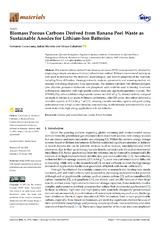Biomass Porous Carbons Derived from Banana Peel Waste as Sustainable Anodes for Lithium-Ion Batteries
Autor
Luna-Lama, Fernando
Morales, Julián
Caballero, Álvaro
Editor
MDPIFecha
2021Materia
Banana peel wasteBiomass
Anode
Li-ion batteries
METS:
Mostrar el registro METSPREMIS:
Mostrar el registro PREMISMetadatos
Mostrar el registro completo del ítemResumen
Disordered carbons derived from banana peel waste (BPW) were successfully obtained by employing a simple one-step activation/carbonization method. Different instrumental techniques were used to characterize the structural, morphological, and textural properties of the materials, including X-ray diffraction, thermogravimetric analysis, porosimetry and scanning electron microscopy with energy-dispersive X-ray spectroscopy. The chemical activation with different porogens (zinc chloride, potassium hydroxide and phosphoric acid) could be used to develop functional carbonaceous structures with high specific surface areas and significant quantities of pores. The BPW@H3PO4 carbon exhibited a high specific surface area (815 m2 g−1), chemical stability and good conductivity for use as an anode in lithium-ion batteries. After 200 cycles, this carbon delivered a reversible capacity of 272 mAh g−1 at 0.2 C, showing a notable retention capacity and good cycling performance even at high current densities, demonstrating its effectiveness and sustainability as an anode material for high-energy applications in Li-ion batteries.

